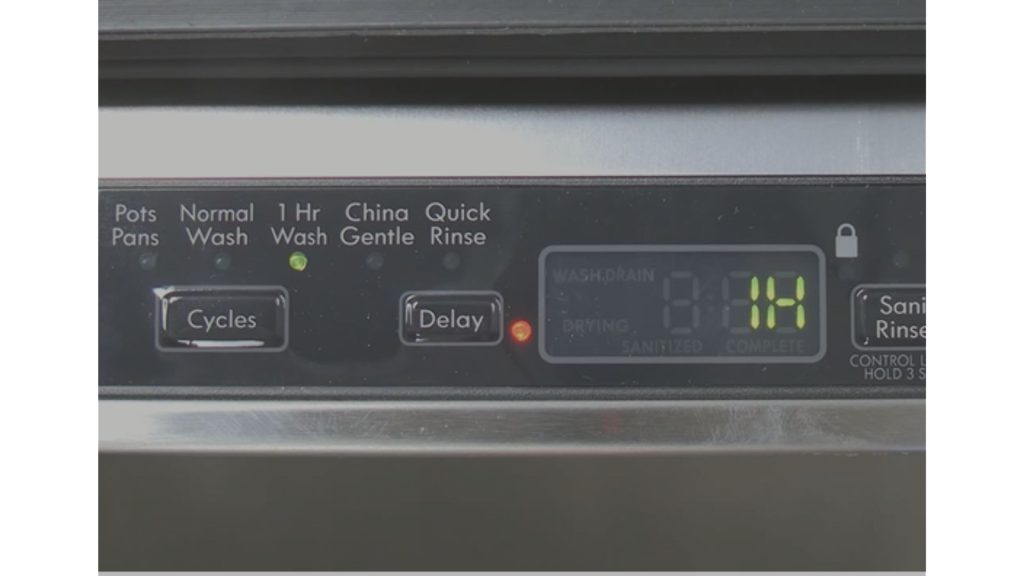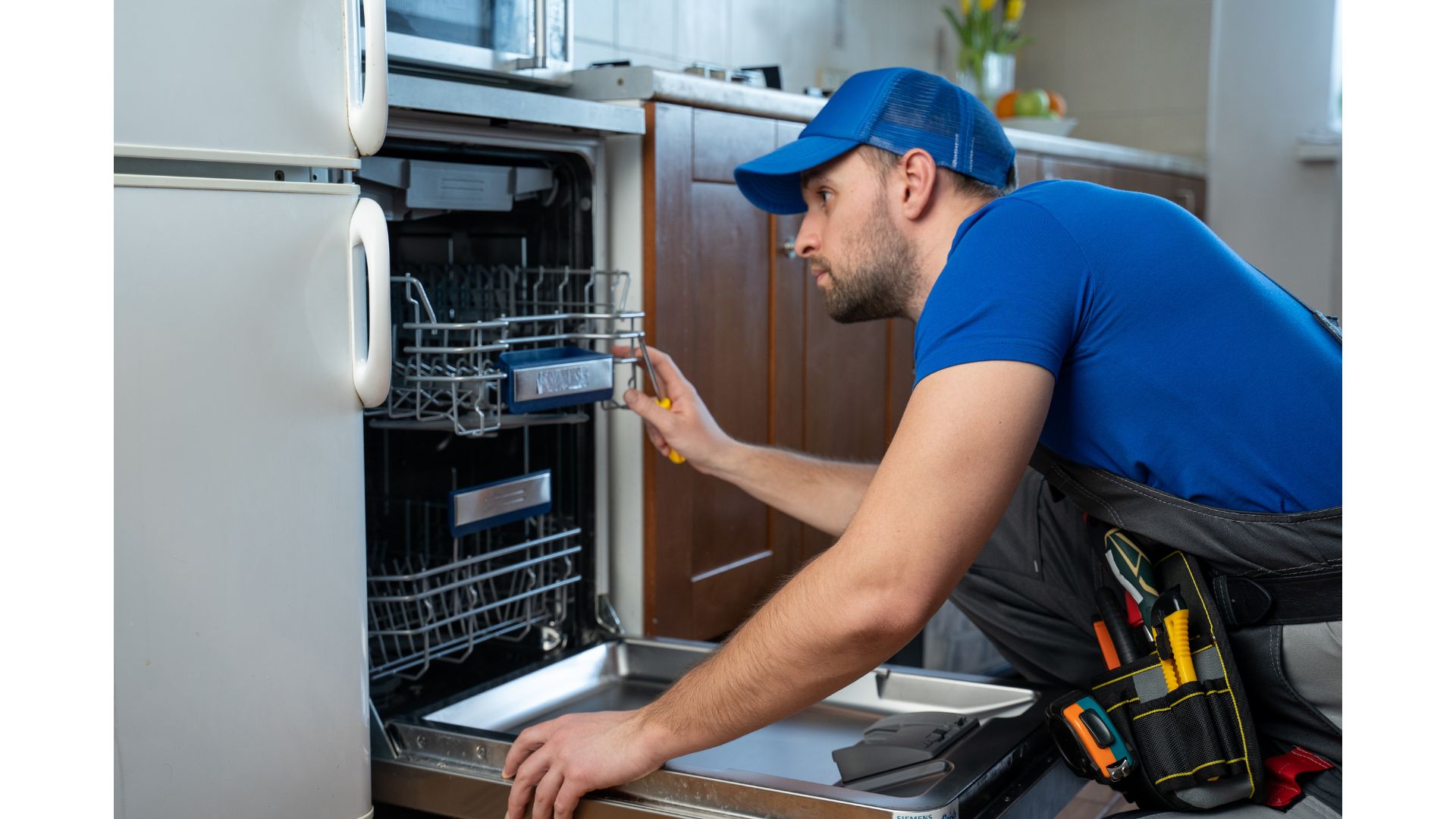GE dishwasher error codes are not all bad. As the guide below will soon reveal, GE dishwasher error codes will show you the state of the appliance.
1h Meaning

1h is not an error code. It appears when you program a one-hour delayed start. In other words, a particular function will start in an hour.
How To Fix It?
- Wait one hour. The wash cycle will start after an hour.
- Press ‘Start’ to cancel the ‘Delay Start.’ The GE dishwasher won’t respond the way you expect until the delay elapses or you cancel it.
- Reset a glitchy machine.
CFE Meaning
- The machine has a glitch.
- The board is defective.
- The water valve is stuck in the open position.
How To Fix It?
- Contributors to this Reddit post used the reset button to remove the CFE error code.
- Unstick a stuck valve.
- Replace a defective valve.
- Restarting the dishwasher may solve the problem.
- Replace a bad main board.
H20 Meaning

- You’re running the dishwasher for the first time.
- You just installed the plumbing, so the pressure is too low.
- The faucet is not fully open.
- The valve is stuck in the closed position, or it’s defective.
- The appliance is not level. Tilting the dishwasher triggers this error code because it affects the water level.
How To Fix It?
- If the dishwasher is new, this error code will only appear at the start. It will disappear eventually.
- Open the faucet fully.
- Fix or replace a damaged valve.
- Position the dishwasher on a level surface. Insert wedges under the legs if the appliance is tilted.
- Ask a plumber to check your pipes for damage and corrosion. They can also provide solutions for low water pressure.
Pr5 Meaning
- The appliance wants you to press ‘Start’ when you select a cycle.
- You have a defective water sensor.
- The appliance has a glitch.
How To Fix It?
- Select a cycle, press start, and close the door. Leaving the door open for more than three seconds will prevent the cycle from starting.
- Disconnect and reconnect the sensor switch wires.
- Perform a reset.
E1 Meaning
- You have a leak.
- Either the leak has triggered the flood switch, or the flood switch is defective.
- Low water pressure
- Damaged impeller.
How To Fix It?
- Make sure you open the faucet fully.
- Identify and remove kinks and blockages in the water lines.
- Replace damaged hoses.
- Replace a damaged impeller.
- Replace a faulty flood switch.
- Perform a reset.
- Drain a flooded dishwasher.
E3 Meaning
- Either the temperature sensor is bad, or the water coming into the dishwasher is too cold.
How To Fix It?
- Perform a reset.
- Replace a defective heater.
- Make sure the water pressure is adequate. Don’t hesitate to call the plumber. They can identify and resolve low pressure in your plumbing system.
- I can also suggest running the water in the sink. Wait until the water is hot before starting the dishwasher.
E4 Meaning
- You see this error code when standing water in the base triggers the flood switch.
- Defective flood switch.
How To Fix It?
- Tilt the appliance to drain the water.
- Look for leaks. If the hose is blocked or damaged, unblock or replace it. If the motor is defective, get a new one.
- Replace a faulty flood switch.
E6 Meaning
- The drain is clogged.
- The drain pump has obstructions.
- The hoses are clogged.
How To Fix It?
- Unclog the hose.
- Unclog the drain.
- Unclog the pump.
- Replace a damaged pump.
- Make sure the pump has an adequate power supply. Tighten loose connections and replace damaged wires.
E8 Meaning
- The circulation pump is broken.
- Defective diverter valve. The paddle inside is stiff from limescale.
How To Fix It?
- Soak the paddle in boiling water.
- Replace a broken circulation pump.
E9 Meaning
- Something touched the button for thirty or more seconds. That includes water. People trigger this error code all the time while taking the dishes out of the appliance. Holding a button down for too long can produce a similar result.
How To Fix It?
- Reset the dishwasher. This involves unplugging it, waiting a few minutes, and plugging it back in. You rarely see reset buttons on dishwashers. If the device is hardwired, use the breaker to perform a reset.
- If a reset doesn’t clear this error code, you have a dead or defective board. You can eliminate some glitches by performing multiple resets. In other cases, you must replace the circuit board.
FTD/fed Error Meaning
- The GE dishwasher has refused to drain.
- If the machine can drain, the pressure sensor is clogged or defective. The dishwasher detects water where there isn’t any.
How To Fix It?
- Remove debris from the drain.
- Check the hose for blockages and remove whatever you find. Severe blockages may compel you to replace the hose.
- Look for kinks in the drain hose. You can remove them to restore the flow of water temporarily. However, kinks tend to re-emerge after a while. If you have the means, replace the kinked hose.
- Check the drain pump. Is it blocked? Remove the obstructions. If the pump is damaged, replace it.
- Check the impeller. A GE dishwasher with a faulty impeller cannot drain. Replace it.
- Inspect the chopper blade. This component breaks debris into smaller pieces. Replace a clogged or damaged chopper blade.
- Clean the pressure sensor.
F96 Meaning
- Either there’s no water in the tub, or the turbidity sensor doesn’t detect water.
- Faulty turbidity sensor.
- Defective inlet valve.
- The turbidity sensor wiring is loose or damaged.
How To Fix It?
- Make sure the dishwasher has an adequate, open water supply.
- Make sure the cut-off valve is open.
- Replace a defective inlet valve.
- Tighten loose connections and replace damaged wires.
- Replace a defective turbidity sensor.
- If the error won’t clear, perform a reset.
F2 Meaning
- The user interface control, and circuit board can’t communicate.
- Defective user interface control.
- Defective circuit board.
How To Fix It?
- Unplug the dishwasher and check the user interface control wiring. If it looks okay, check the control board wiring. Replace damaged wire harnesses.
- Replace a defective user interface control.
- Replace a faulty circuit board.
- Try a reset. It may eliminate the glitch.
F128 Meaning
- The unit has detected low levels of rinse aid. Dishwashers have a rinse aid detection system that works with a sensor in the d-cup module. A defective rinse aid detection system can trick the dishwasher into thinking that it doesn’t have enough rinse aid.
How To Fix It?
- Add the correct rinse agent to the appropriate dispenser.
- Perform a reset to eliminate glitches that prevent the F128 error code from fading even when you add the rinse agent. You should also consider replacing the circuit board.
F1 Meaning
- The base pan has water.
- The filter is clogged.
- The drain is blocked.
- The lid seal is worn out.
- The water inlet valve is leaking.
How To Fix It?
- If the dishwasher leaks or floods, shut the water supply off before performing the appropriate repairs. You should also turn the power off. This could mean pulling the dishwasher’s plug from the outlet or cutting the power at the breaker.
- Check the drain pan and remove any water you see.
- Check the drain pan, hoses, and pipes for leaks. Replace every torn or broken component. Otherwise, the leaks will persist.
- Check the filter for blockages. You can either clean the filter or replace it, depending on the severity of the blockage.
- If you can’t see any signs of flooding, check the switches and sensors. A fault may trick the dishwasher into thinking it has flooded. You should also inspect the circuit board. The board runs everything. Perform a reset. If the error code persists, replace the board.
F16 Meaning
- High water temperature.
- Damaged temperature sensor.
- Loose connections on the temperature sensor.
- The flood switch is dirty.
- The flood switch is defective.
- The door is open, or the door switch is faulty.
How To Fix It?
- Test the flood switch’s resistance. If the readings are correct, clean the component. Clean any gunk you can see and run a cleaning cycle.
- If the flood switch is dead, get a replacement.
- Fix or replace a faulty door switch.
- Replace a defective temperature sensor.
- Look for loose connections and tighten them. You should also replace damaged wires.
FF Meaning
GE dishwashers don’t use an FF error code. Check the display. Are you sure it says ‘FF,’ or have you confused it for a different code? What does the manual say? If the manual doesn’t mention the error code, the dishwasher has an electronic glitch. An electronic glitch can compel an appliance to generate gibberish on the display.
How To Fix It?
GE dishwashers rarely use FF error codes, if ever. Check the manual to determine what FF means and how to solve it. If the manual mentions FF, make sure you have the correct documentation.
You typically see FF in GE refrigerators. They appear when the temperature is too high and your frozen food is in danger of thawing. If your GE dishwasher shows FF, but you can’t see it in the manual, contact GE’s customer support personnel.
112 Meaning
Do you see an ‘F’ before the ‘112?’ The keypad has a stuck button.
How To Fix It?
Look for stuck buttons. If you identify them, free them. Some people will replace the user interface control. Ask a professional to test and inspect the component beforehand. They will encourage you to either repair or replace it.
815 Meaning
What other symptoms have you noticed? Have the controls refused to respond? The main control board is dead.
How To Fix It?
Get the dishwasher’s model number, and use it to identify a replacement control board.

